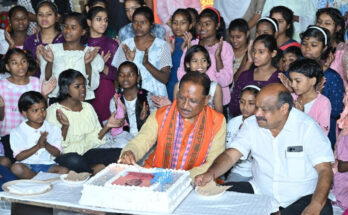Dr. Daneshwari Sambhakar
Raipur, 26 July 2022
Hareli Tihar is the first festival of Chhattisgarh, which introduces people to the culture and faith of Chhattisgarh. Hareli means greenery, which is celebrated every year on the new moon of the month of Sawan. Hareli is mainly a festival related to agriculture. Before this festival, the farmers sow or transplant their crops and on this day all the agricultural implements, including nagar, pickaxe, hoe, shovel, and all kinds of agricultural implements are cleaned and kept at one place. Do worship. At home, women prepare different types of Chhattisgarhi dishes, especially jaggery cheela. In Hareli, where farmers worship agricultural implements and enjoy food, coconut throwing competitions are held among themselves, while youth and children enjoy climbing the cart.
In order to preserve and promote the culture of Chhattisgarh, in the course of important steps taken by the government during the last three and a half years, now public holidays are also given on local Teej-festivals. These include Hareli Tihar. Other folk festivals on which public holidays are observed are Teeja, Maa Karma Jayanti, Maa Shakambhari Jayanti (Cherchera), World Tribal Day and Chhath. Now these Teej-festivals are celebrated on a large scale in the state. In which the government also participates. Important government events are held during these festivals and important government announcements are also made. In the year 2020, on the day of Hareli festival, Chief Minister Shri Bhupesh Baghel had started Godhan Nyay Yojana, which has become an example for other states due to its success in just 02 years. This scheme is being followed by many states of the country. From the upcoming Hareli Tihar from July 28, while expanding this scheme further, it has now been decided to purchase cow urine along with cow dung.
On the day of Hareli, the people of the Yadav community, who are associated with animal husbandry work in the village, go to all the houses since morning and feed salt and Bagaranda leaves to cows, bulls and buffaloes. On the day of Hareli, the inquiries of blacksmiths increase from village to village. On this day the blacksmiths of the village bless the main gate of every house by planting neem leaves and hammering nails into the door frame. It is believed that by doing this the people living in that house are protected from evil. In return, the farmers voluntarily give them pulses, rice, vegetables and cash as a donation. The villagers make pictures made of cow dung outside the house, so that he protects them.
Gedi race is organized from Hareli to Teeja
On the day of Hareli festival, Gedi is made in every house of the village, mainly it is a game of men, as many youths and children as there are in the house, as many Gedi is made. The Gedi race starts from Hareli till the day when there is a program of eating stale food at the time of Teeja Pola in Bhado. Children go to the pond, while taking a bath, leave the gedi in the pond, then wait for Hareli, not climbing on the carriage throughout the year. There is an important side behind the Gedi, which is practiced in the rainy season. Due to rain, mud fills many places in the village, At this time, children climb the car and go from one place to another, there is no fear of getting mud in it. Children can come from anywhere with the help of a cart. Gedi is also related to mud. Teenagers and young people especially enjoy Gedi when walking in the mud. The more mud on the way, the more enjoyment the cart is. At present, there has been a lot of improvement in the village, work has been done on the streets and roads. Now there is neither mud nor swamps in the streets. Nevertheless, Gedi still holds its importance in Chhattisgarh. When children walk together in the Gadi, the desire to go ahead is awakened in them and this becomes a competition. According to the height of the children, nails are placed in two bamboos at an equal distance and by tearing the piece of bamboo in the middle, it is divided into two, Then one end is tied with a rope and rejoined, it is called Pawa. The open part of the pauva is trapped on the nail in the bamboo, just below the pauva, adjacent to the bamboo, 4-5 inches long wood is tied with a rope in such a way that it cannot go down, the wood is also known as mare. While walking in a cart, to make a loud sound, pressure is applied on the foot, which is called swaying.
Coconut Throwing Competition
Coconut throwing is a game of adults, in which children do not participate. The competition coordinator arranges the coconut, if one coconut gets spoiled then immediately the other coconut is included in the game. The distance is decided before the start of the game, then a condition is placed that how many times the coconut will be thrown and the said distance will be crossed. The participant accepts the condition, if the coconut crosses the distance in as many times as has been fixed, then that coconut becomes his. If the coconut fails to be thrown, he has to buy a coconut and pay it. Throwing a coconut is hard work, it requires practice. Being a game related to the festival, people participate without any preparation.
Amus festival is celebrated in Bastar region on Hariyali Amavasya
In the Bastar region of Chhattisgarh, villagers celebrate Hariyali Amavasya by planting a thin stick of tendu tree with medicinal herbs in their fields. On the upper end of this stick, Shatavar, Rasna Jadi, Keu tuber are tied in the leaves of Bhelwan. The belief of the villagers behind sticking this stick in the fields is that it protects the crop from the wrath of insects and other diseases. Herbs are also fed to cattle on this occasion. For this, preparations are made by the farmers a day in advance. Herbs brought from the forest include raspana, keu tubers, asparagus leaves and other vegetation, wrapped in leaves and fed to cattle. Villagers believe that it helps in getting rid of injuries and sprains caused during agricultural work. On this day the ritual of Rog Bohrani is also done. In which the villagers hang the broken bamboo soup-basket-broom and other things after use on the tree outside the outskirts of the village. In South Bastar, this festival is celebrated not only on Hariyali Amavasya in all the villages, but after that in the villages within the next fortnight after fixing some day.




